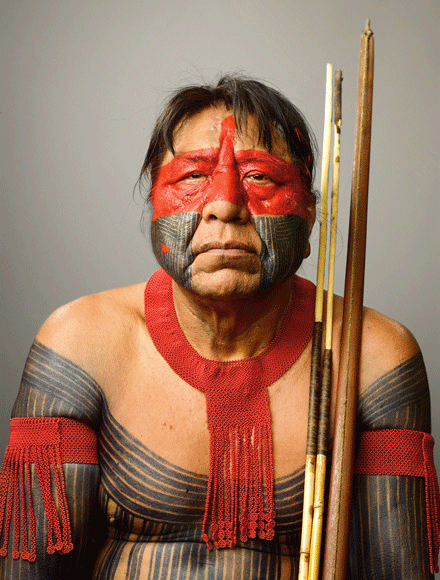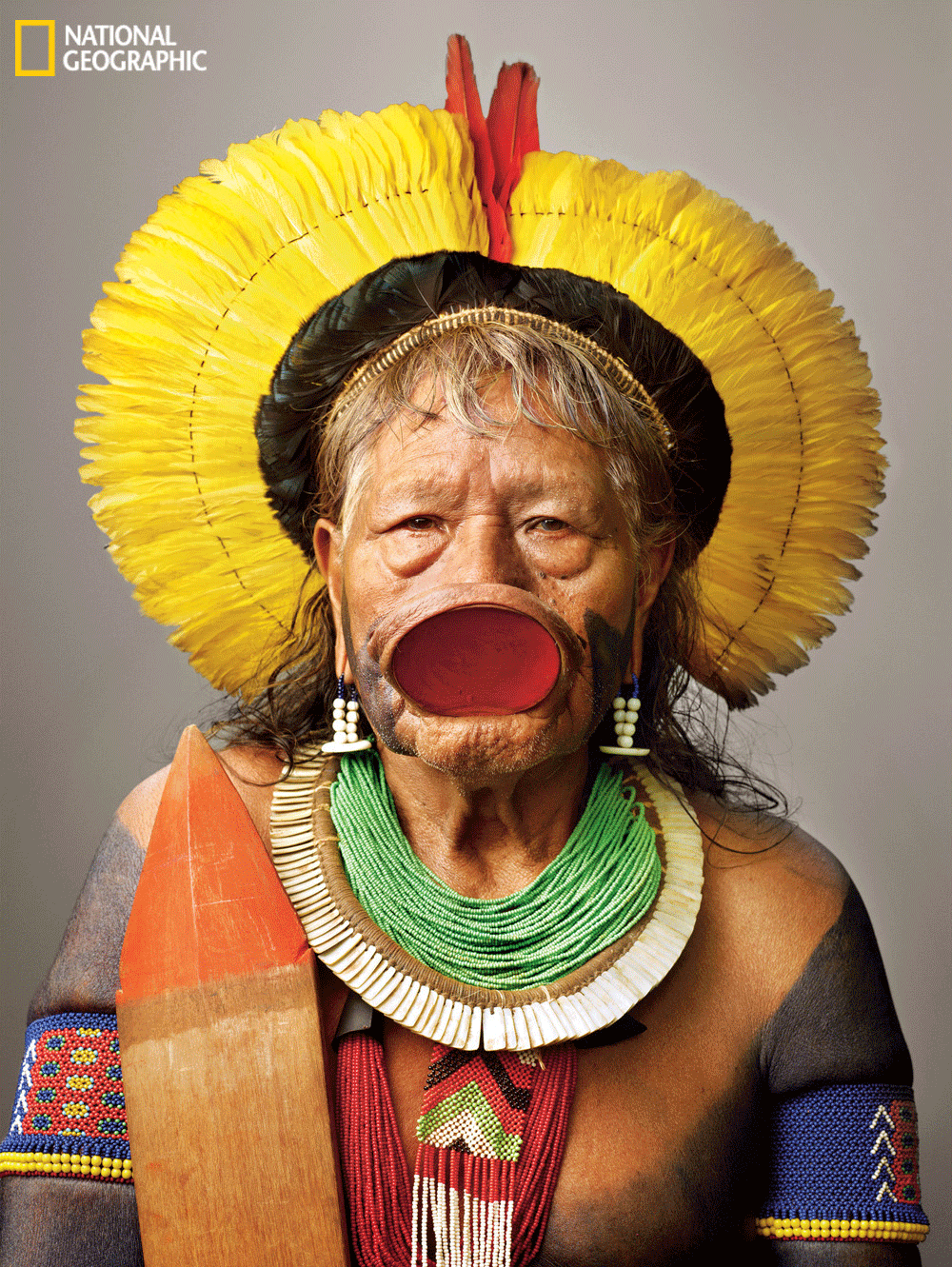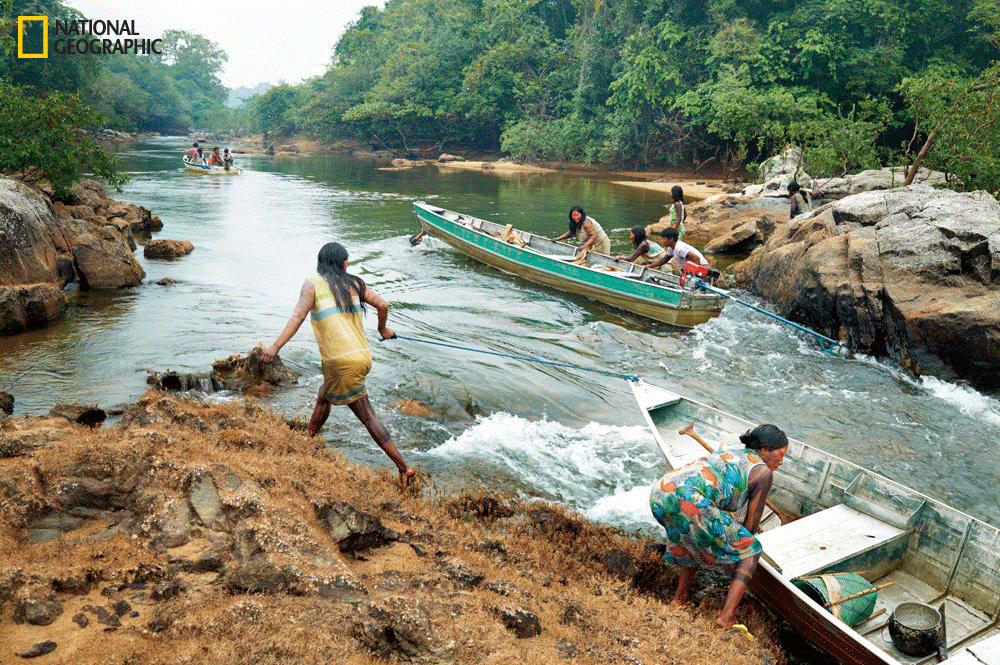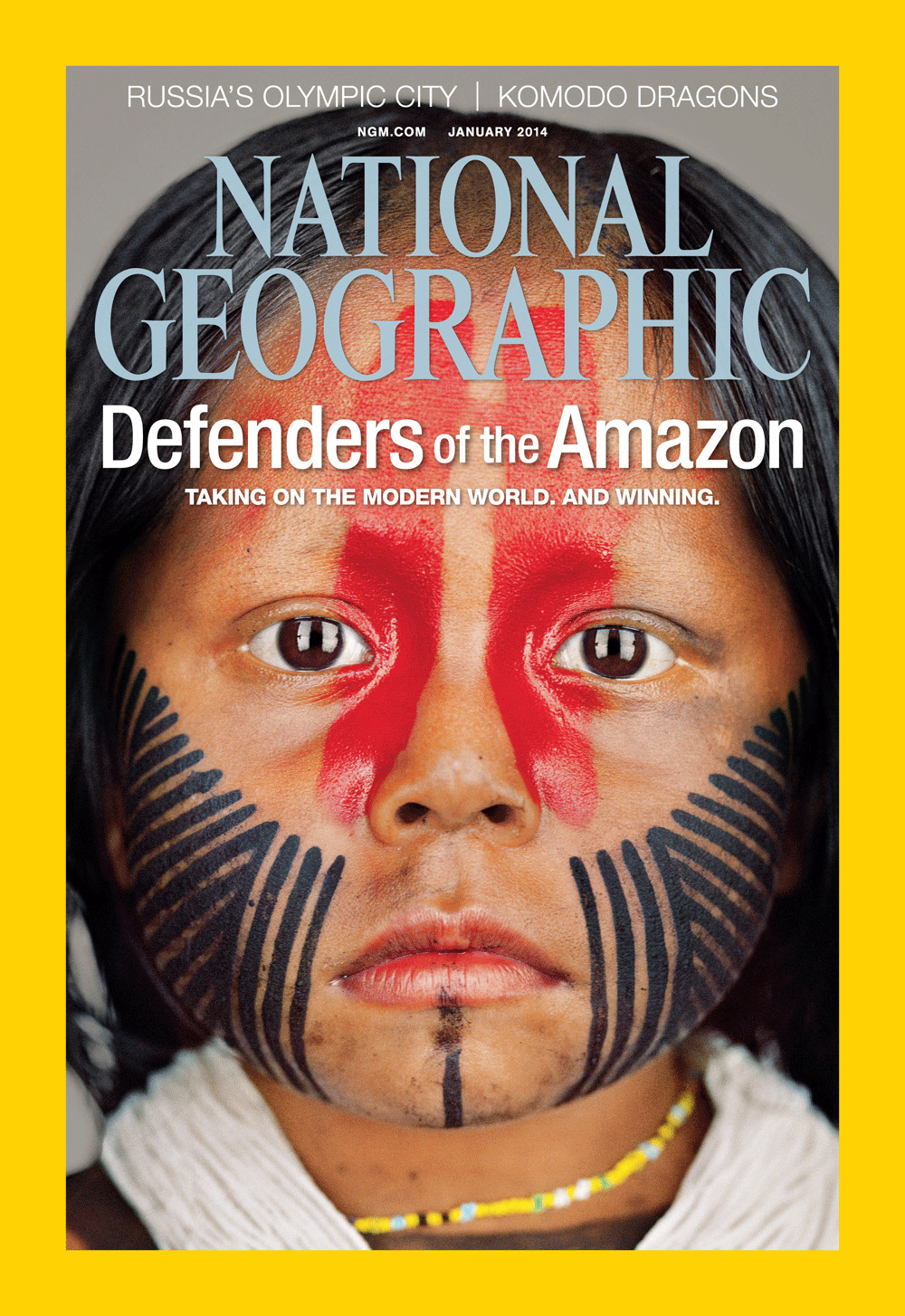Protecting the Amazon, Preserving Culture
Air Date: Week of February 28, 2014

Kayapo who live near border towns supplement their subsistence diet with trips to the supermarket, like this man in Tucumã. (© Martin Schoeller/National Geographic)
Para state in Brazil is ground zero for deforestation and dam construction. It’s also home to indigenous tribes like the Kayapo. Recently featured on the cover of National Geographic, the Kayapo are adopting modern technology like cell phones and Facebook while continuing to maintain their cultural traditions and protect the forest. A chief of the tribe, Megaron Ti, talks with Living on Earth’s Bobby Bascomb.
Transcript
CURWOOD: It's Living on Earth, I'm Steve Curwood. For the past decade, deforestation rates in the Brazilian Amazon have been falling, but a recent spike has conservationists concerned. Most experts agree that when it comes to protecting the rainforest, no one does it better than the indigenous people who have lived there for centuries. They include the 9,000 strong Kayapo tribe in Brazil with a territory the size of Pennsylvania.
[MUSIC: Breno Mello “Samba De Orfeu” from Black Orpheus: The Original Soundtrack (Hallmark Records) Happy Happy Carnival Time]
CURWOOD: Earlier this year, National Geographic magazine featured the struggle of the Kayapo to protect their rainforest. A chief of the tribe, Megaron-Ti, travelled to the North America seeking support for his people, and talked with Living on Earth’s Bobby Bascomb through a translator.
MEGARON: [Oi, bon dia. ] Hello.
BASCOMB: Chief, are you enjoying your time in the United States?
MEGARON: Yes, I’m really enjoying being able to spend time with the NGOs that support us. I hope they will continue to support us and our people’s struggle to preserve our land, our culture, our language.

Megaron- Ti is a chief of the Kayapo people and an international advocate for their rights. (©Martin Schoeller/National Geographic)
BASCOMB: How about the weather in Toronto though? Come on.
MEGARON: [Toronto muito frio…. ] Toronto is very cold, a lot of snow and ice. I’ve never seen snow before. I was very cold in New York and Toronto.
BASCOMB: I’m sure, a far cry from the Amazon. So, chief, what brings you to the United States now on this trip?
MEGARON: I’ve come to explain to the public about how we live and the land, the forest that the Brazilian government has demarcated for us and our struggle to preserve this forest.
BASCOMB: We’re talking to you now from Sacramento, California, a state, which is exploring the idea of paying for carbon credits in rainforest communities like yours. Is that something that you are focused on with this trip to California?
MEGARON: Yes, several years ago a Brazilian NGO that works with us began a discussion about carbon credits for reducing deforestation. We talked about this among our people but then the discussion stopped. We think it’s important to re-start this discussion. So, I’ve come here to learn more and when I return I want to restart this important discussion about carbon credits.
BASCOMB: Can you tell me about the relationship between the Kayapo people and the rainforest?
MEGARON: The Kayapo people have always lived in the forest without destroying it. The major wealth of the forest for us is food. There are many different kinds of food both plants and animals. There are Brazil nuts and acai palm berries. We’ve always used these resources in a sustainable way, we’ve always preserved the forest and we plan to continue preserving it into the future.
BASCOMB: Megaron, can you tell me about your tribe and sort of describe daily life in your village of Kenjam?
MEGARON: The daily life of the Kayapo people is to hunt animals in the forest and fish to feed our families. Every family has its own garden. They plant corn, manioc, and sweet potatoes. Our daily life really revolve around these things in addition to our traditional ceremonies and rituals, which people continue practicing.

Ropini, an internationally known chief, is one of the few Kayapo who still wear the mahogany lip plate. (©Martin Schoeller/National Geographic)
BASCOMB: So, chief you are 63 years old, I’m told. In your lifetime what kind of changes have you seen in your village, your people, your way of life?
MEGARON: One thing I’ve noted is for a number of years now the weather has been changing. It rains out of season. There are very strong winds, intense drought and then very strong rains and floods. All these things we didn’t see before. And it’s because around our territory there’s been a lot of deforestation and this is going to be extremely dangerous for our children and our grandchildren.
BASCOMB: Do you think those changes in weather that you’ve noticed, can that be attributed to climate change?
MEGARON: Yes, I think what’s causing the changes that we’ve seen are things that people are doing. It’s deforestation, it’s building dams, it’s large-scale industry and all the smoke and pollution that they put into the atmosphere. It is climate change and it’s very dangerous.

The village of Kendjam, which in Kayapo means “standing stone,” is named for Kendjam Mountain—a precipitous formation that provides a rare overview of the tribe’s territory. The Kayapo often go to the highlands in search of medicinal plants. (©Martin Schoeller/National Geographic)
BASCOMB: The Belo Monte hydroelectric dam on the Xingu has been in and out of court over the last decade with developers and the government pitted against environmental and indigenous groups. But that’s not the only dam in the works, there are several others being proposed. How exactly will those affect the Kayapo tribe?
MEGARON: In years gone by the government proposed building a dam today known as Belo Monte. Our former leaders, many of whom are no longer with us, got together and struggled against the dam to make the government respect indigenous peoples and their land. And now that dam is being constructed and we know the government has plans to build other dams. This is very dangerous for our people. Some of the dams will be in Kayapo territory. They could flood our territory.
BASCOMB: Back in the 1980s and 90s I understand that the Kayapo people formed partnerships with gold miners and sold logging rights to loggers. How did that work out for the tribe? What was the relationship there?
MEGARON: It was very bad for the Kayapo. In the 80s and 90s the loggers came and forced our leaders to sign contracts and extract timber. Miners came and forced the Kayapo to make agreements with them. As time went on we saw that the forest was being destroyed. Gold mining was destroying the land and the rivers. So people turned against logging and mining. It was a very bad experience for us.

The January cover of National Geographic. (©Martin Schoeller/National Geographic)
BASCOMB: So, National Geographic ran a cover story about you and your tribe and the pictures that go along with it show people covered in body paint and warriors wearing a head dress of parrot feathers and then there’s a photo of a Kayapo warrior in that traditional dress in a modern grocery store and he’s pushing a cart through the meat department. The juxtaposition of that photo is really striking. Can you tell me about some of the ways your people have adapted to the changing world around them?
MEGARON: In my lifetime cities have grown up around our territory but our people continue to maintain our customs and traditions. We use body painting, and feather head dresses and other kinds of ornaments that we use in our ceremonies. At the same time our young people are on the internet. They use cell phones, they use Facebook. All the Kayapo villages have radios that they use to communicate with each other. So, we’ve adopted a lot of things from the white people’s world but we also continue to maintain our traditions, our language, our music, our culture.
BASCOMB: Do you have children yourself, chief?
MEGARON: I have 9 children, 5 girls and 4 boys and I’m not sure how many grandchildren. I think 10 or 15 grandchildren.
BASCOMB: And when you see them using cell phones and Facebook and the internet and all those things. How does that make you feel? Do you ever worry perhapsabout losing some of your tribal identity, perhaps, adopting these new technologies?
MEGARON: My children have gone to school, some of them to college, but they’ve returned to the village to help their people. I hope my grandchildren will do the same thing. At the same time I am concerned. I know my children and grandchildren can learn bad things from the white people’s world but my hope is that they’ll be able to learn white people’s things but also maintain their culture, their traditions, their language, and their customs.
BASCOMB: So, now looking into the future, what are your greatest hopes and fears for your people, for the forest?
MEGARON: I’m very worried about the deforestation and dam construction that could destroy our way of life. I’m also very concerned that politicians in Brazil are saying that they want to reduce already demarcated indigenous lands. We are afraid that these initiatives will go forward and deprive us of the resources that allow us to live our traditional life. But I hope that the Kayapo will continue to fight to preserve the forest. To defend our land, our customs, our language -- to go on and maintain our way of life.
BASCOMB: Chief, thanks so much for your time. Good luck with the rest of your trip and your struggles back home.
MEGARON: Thanks to you for letting me talk about my people and our struggle. Thanks very much, good bye. [Muito obrigado, cio!]
CURWOOD: Kayapo chief Megaron-Ti speaking with Living on Earth's Bobby Bascomb.
Links
Living on Earth wants to hear from you!
Living on Earth
62 Calef Highway, Suite 212
Lee, NH 03861
Telephone: 617-287-4121
E-mail: comments@loe.org
Newsletter [Click here]
Donate to Living on Earth!
Living on Earth is an independent media program and relies entirely on contributions from listeners and institutions supporting public service. Please donate now to preserve an independent environmental voice.
NewsletterLiving on Earth offers a weekly delivery of the show's rundown to your mailbox. Sign up for our newsletter today!
 Sailors For The Sea: Be the change you want to sea.
Sailors For The Sea: Be the change you want to sea.
 The Grantham Foundation for the Protection of the Environment: Committed to protecting and improving the health of the global environment.
The Grantham Foundation for the Protection of the Environment: Committed to protecting and improving the health of the global environment.
 Contribute to Living on Earth and receive, as our gift to you, an archival print of one of Mark Seth Lender's extraordinary wildlife photographs. Follow the link to see Mark's current collection of photographs.
Contribute to Living on Earth and receive, as our gift to you, an archival print of one of Mark Seth Lender's extraordinary wildlife photographs. Follow the link to see Mark's current collection of photographs.
 Buy a signed copy of Mark Seth Lender's book Smeagull the Seagull & support Living on Earth
Buy a signed copy of Mark Seth Lender's book Smeagull the Seagull & support Living on Earth

